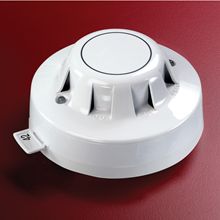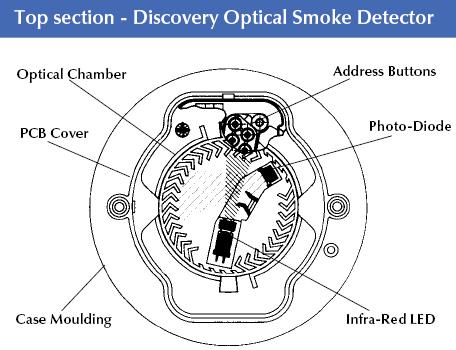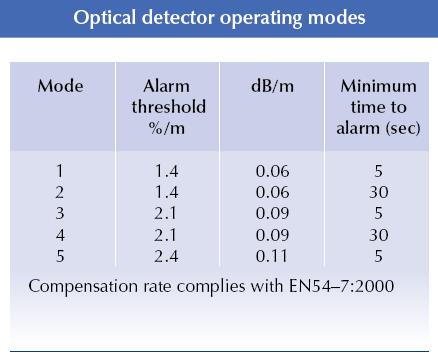DISCOVERY, Оптический дымовой детектор, 58000-600
 | Оптический дымовой детектор, |
Drift compensation
Al l Discovery smoke detectors include compensation for sensor drift as part of the internal signalprocessing algorithm. The algorithm will compensate for changes in sensor output caused, for example, by dust in the chamber, and will therefore hold the sensitivity at a constant level even with severe chamber contamination.
This increased stability is achieved without significantly affecting the detector’s sensitivity to fire.
The compensation level is stored in the detector’s memory as a single value between 0 and 31. The normal level, that is, with no compensation applied, is 16. Values above or below this indicate drift towards alarm or away from alarm respectively.
For compensation values in the range 4 to 30 the detector is working within its allowable range. A value which is less than 4 or greater than 30 results in a warning flag. A value of zero results in a fault signal.
The maximum compensation that can be applied is 31. If further drift occurs, the analogue values will simply track the drift and the detector will become more sensitive.
Compensation values are stored in nonvolatile memory and will be retained even if detectors are disconnected. With few exceptions, it is possible to use the control panel to ascertain the level of compensation applied at any time.
For the Discovery smoke detectors, the compensation algorithms are designed such that the detectors meet the requirements of the European standard EN54–7:2000 in all response modes.
It is possible, through the protocol, to carry out a normalisation procedure which rapidly “updates” the drift compensation. This facility should only be used after a compensated detector has been cleaned and instant confirmation is required. (Otherwise the detector will automatically update itself within 24 hours).
Operating Principles
The Discovery Optical Detector has a white moulded polycarbonate case with wind-resistant smoke inlets. The indicator LEDs are colourless when the detector is in quiescent state and red in alarm.
Within the case is a printed circuit board which, on one side, has the light-proof chamber with integral gauze surrounding the optical measuring system and, on the other, the signal processing and communications electronics.
An infra-red light emitting diode within its collimator is arranged at an obtuse angle to the photo-diode. The photo-diode has an integral daylight-blocking filter.
The IR LED emits a burst of collimated light every second. In clear air the photodiode receives no light directly from the IR LED, because of the angular arrangement and the chamber baffles. When smoke enters the chamber it scatters light from the emitter IR LED onto the photo-diode in an amount related to the smoke characteristics and density. The photodiode signal is processed to provide an analogue value for transmission when the detector is interrogated.
ТЕХНИЧЕСКИЕ ХАРАКТЕРИСТИКИ
| Detection principle: | Photo-electric detection of light scattered in a forward direction by smoke particles |
| Chamber configuration: | Horizontal optical bench housing infra-red emitter and sensor, arranged radially to detect forward scattered light |
| Sensor: | Silicon PIN photo-diode |
| Emitter: | GaAlAs infra-red light emitting diode |
| Sampling frequency: | 1 per second |
| Supply wiring: | Two-wire supply, polarity insensitive |
| Terminal functions: | L1 & L2 supply in and out connections +R remote indicator positive connection (internal 2.2kΩ resistance to positive) –R remote indicator negative connection (internal 2.2kΩ resistance to negative) |
| Operating voltage: | 17–28V DC |
| Communication protocol: | Apollo Discovery 5–9V peak to peak |
| Quiescent current: | 300μA |
| Power-up surge current: | 1mA |
| Maximum power-up time: | 10s |
| Alarm current, LED illuminated: | 3.5mA |
| Remote output characteristics: | Connects to positive line through 4.5kΩ (5mA maximum) |
| Clean-air analogue value: | 23 +4/–0 |
| Alarm level analogue value: | 55 |
| Alarm Indicator: | 2 colourless Light Emitting Diodes (LEDs); illuminating red in alarm. Optional remote LED |
| Temperature range: | –40°C to +70°C |
| Humidity: | 0 to 95% relative (no condensation or icing) |
| Effect of atmospheric pressure: | None |
| Effect of wind: | None |
| Vibration, Impact and Shock: | To EN54–7:2000 |
| IP rating: | 44 in accordance with BSEN60529 |
| Approvals & Standards: | See page 29 |
| Dimensions: | 100mm diameter x 42mm height 50mm (height in base) |
| Weight: | Detector 105g Detector in base 160g |
| Materials: | Housing: White polycarbonate V–0 rated to UL94 Terminals: Nickel plated stainless steel |

